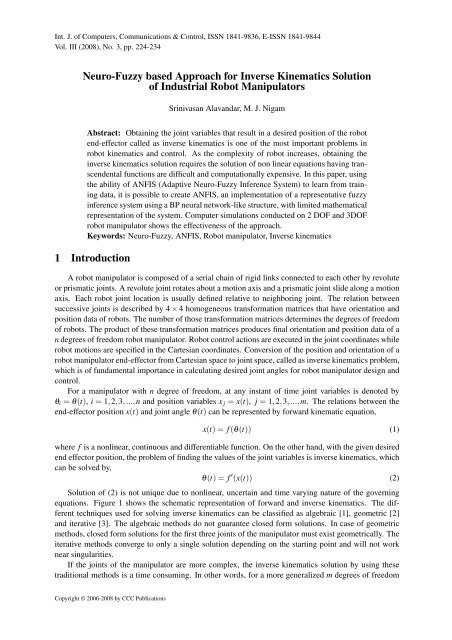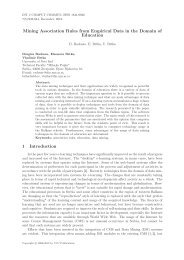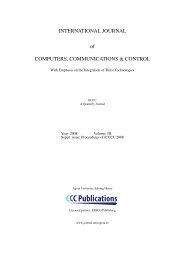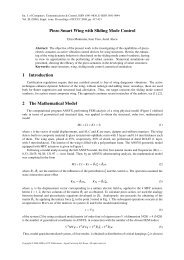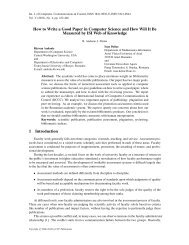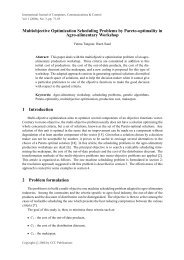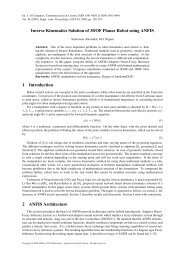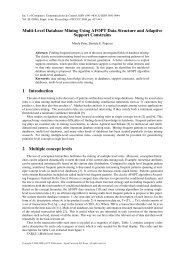Neuro-Fuzzy based Approach for Inverse Kinematics Solution of ...
Neuro-Fuzzy based Approach for Inverse Kinematics Solution of ...
Neuro-Fuzzy based Approach for Inverse Kinematics Solution of ...
Create successful ePaper yourself
Turn your PDF publications into a flip-book with our unique Google optimized e-Paper software.
Int. J. <strong>of</strong> Computers, Communications & Control, ISSN 1841-9836, E-ISSN 1841-9844<br />
Vol. III (2008), No. 3, pp. 224-234<br />
<strong>Neuro</strong>-<strong>Fuzzy</strong> <strong>based</strong> <strong>Approach</strong> <strong>for</strong> <strong>Inverse</strong> <strong>Kinematics</strong> <strong>Solution</strong><br />
<strong>of</strong> Industrial Robot Manipulators<br />
Srinivasan Alavandar, M. J. Nigam<br />
Abstract: Obtaining the joint variables that result in a desired position <strong>of</strong> the robot<br />
end-effector called as inverse kinematics is one <strong>of</strong> the most important problems in<br />
robot kinematics and control. As the complexity <strong>of</strong> robot increases, obtaining the<br />
inverse kinematics solution requires the solution <strong>of</strong> non linear equations having transcendental<br />
functions are difficult and computationally expensive. In this paper, using<br />
the ability <strong>of</strong> ANFIS (Adaptive <strong>Neuro</strong>-<strong>Fuzzy</strong> Inference System) to learn from training<br />
data, it is possible to create ANFIS, an implementation <strong>of</strong> a representative fuzzy<br />
inference system using a BP neural network-like structure, with limited mathematical<br />
representation <strong>of</strong> the system. Computer simulations conducted on 2 DOF and 3DOF<br />
robot manipulator shows the effectiveness <strong>of</strong> the approach.<br />
Keywords: <strong>Neuro</strong>-<strong>Fuzzy</strong>, ANFIS, Robot manipulator, <strong>Inverse</strong> kinematics<br />
1 Introduction<br />
A robot manipulator is composed <strong>of</strong> a serial chain <strong>of</strong> rigid links connected to each other by revolute<br />
or prismatic joints. A revolute joint rotates about a motion axis and a prismatic joint slide along a motion<br />
axis. Each robot joint location is usually defined relative to neighboring joint. The relation between<br />
successive joints is described by 4 × 4 homogeneous trans<strong>for</strong>mation matrices that have orientation and<br />
position data <strong>of</strong> robots. The number <strong>of</strong> those trans<strong>for</strong>mation matrices determines the degrees <strong>of</strong> freedom<br />
<strong>of</strong> robots. The product <strong>of</strong> these trans<strong>for</strong>mation matrices produces final orientation and position data <strong>of</strong> a<br />
n degrees <strong>of</strong> freedom robot manipulator. Robot control actions are executed in the joint coordinates while<br />
robot motions are specified in the Cartesian coordinates. Conversion <strong>of</strong> the position and orientation <strong>of</strong> a<br />
robot manipulator end-effector from Cartesian space to joint space, called as inverse kinematics problem,<br />
which is <strong>of</strong> fundamental importance in calculating desired joint angles <strong>for</strong> robot manipulator design and<br />
control.<br />
For a manipulator with n degree <strong>of</strong> freedom, at any instant <strong>of</strong> time joint variables is denoted by<br />
θi = θ(t), i = 1,2,3,...,n and position variables x j = x(t), j = 1,2,3,...,m. The relations between the<br />
end-effector position x(t) and joint angle θ(t) can be represented by <strong>for</strong>ward kinematic equation,<br />
x(t) = f (θ(t)) (1)<br />
where f is a nonlinear, continuous and differentiable function. On the other hand, with the given desired<br />
end effector position, the problem <strong>of</strong> finding the values <strong>of</strong> the joint variables is inverse kinematics, which<br />
can be solved by,<br />
θ(t) = f ′ (x(t)) (2)<br />
<strong>Solution</strong> <strong>of</strong> (2) is not unique due to nonlinear, uncertain and time varying nature <strong>of</strong> the governing<br />
equations. Figure 1 shows the schematic representation <strong>of</strong> <strong>for</strong>ward and inverse kinematics. The different<br />
techniques used <strong>for</strong> solving inverse kinematics can be classified as algebraic [1], geometric [2]<br />
and iterative [3]. The algebraic methods do not guarantee closed <strong>for</strong>m solutions. In case <strong>of</strong> geometric<br />
methods, closed <strong>for</strong>m solutions <strong>for</strong> the first three joints <strong>of</strong> the manipulator must exist geometrically. The<br />
iterative methods converge to only a single solution depending on the starting point and will not work<br />
near singularities.<br />
If the joints <strong>of</strong> the manipulator are more complex, the inverse kinematics solution by using these<br />
traditional methods is a time consuming. In other words, <strong>for</strong> a more generalized m degrees <strong>of</strong> freedom<br />
Copyright © 2006-2008 by CCC Publications
<strong>Neuro</strong>-<strong>Fuzzy</strong> <strong>based</strong> <strong>Approach</strong> <strong>for</strong> <strong>Inverse</strong> <strong>Kinematics</strong> <strong>Solution</strong><br />
<strong>of</strong> Industrial Robot Manipulators 225<br />
manipulator, traditional methods will become prohibitive due to the high complexity <strong>of</strong> mathematical<br />
structure <strong>of</strong> the <strong>for</strong>mulation. To compound the problem further, robots have to work in the real world that<br />
cannot be modeled concisely using mathematical expressions. In recent years, there have been increasing<br />
Joint space<br />
variables<br />
Forward kinematics<br />
<strong>Inverse</strong> kinematics<br />
Task space<br />
variables<br />
Figure 1: Schematic representation <strong>of</strong> <strong>for</strong>ward and inverse kinematics<br />
research interest <strong>of</strong> artificial neural networks and many ef<strong>for</strong>ts have been made on applications <strong>of</strong> neural<br />
networks to various control problems. The most significant features <strong>of</strong> neural networks are the extreme<br />
flexibility due to the learning ability and the capability <strong>of</strong> nonlinear functions approximations. This fact<br />
leads us to expect neural networks to be a excellent tool <strong>for</strong> solving the inverse kinematics problem in<br />
robot manipulators with overcoming the difficulties <strong>of</strong> algebraic, geometric and iterative methods.<br />
<strong>Fuzzy</strong> Inference Systems are the most popular constituent <strong>of</strong> the s<strong>of</strong>t computing area since they are<br />
able to represent human expertise in the <strong>for</strong>m <strong>of</strong> IF antecedent THEN consequent statements. In this<br />
domain, the system behavior is modeled through the use <strong>of</strong> linguistic descriptions. Although the earliest<br />
work by Pr<strong>of</strong>. Zadeh on fuzzy systems has not been paid as much attention as it deserved in early<br />
1960s, since then the methodology has become a well-developed framework. The typical architectures<br />
<strong>of</strong> fuzzy inference systems are those introduced by Wang [4][5], Takagi and Sugeno [6] and Jang [7].<br />
In [4], a fuzzy system having Gaussian membership functions, product inference rule and weighted<br />
average defuzzifier is constructed and has become the standard method in most applications. Takagi and<br />
Sugeno change the defuzzification procedure where dynamic systems are introduced as defuzzification<br />
subsystems. The potential advantage <strong>of</strong> the method is that under certain constraints, the stability <strong>of</strong> the<br />
system can be studied.<br />
Utilization <strong>of</strong> Neural networks (NN) and <strong>Fuzzy</strong> logic <strong>for</strong> solving the inverse kinematics is much<br />
reported [8]-[13]. Li-Xin Wei et al [14]., and Rasit Koker et al [15]., proposed neural network <strong>based</strong><br />
inverse kinematics solution <strong>of</strong> a robotic manipulator. There exist numerous possibilities <strong>for</strong> the fusion <strong>of</strong><br />
neural networks and fuzzy logic technique so that both <strong>of</strong> them can overcome their individual drawbacks<br />
as well as benefit from each other’s merits. Jang et al [16]., propose an Adaptive <strong>Neuro</strong> <strong>Fuzzy</strong> Inference<br />
System, in which a polynomial is used as the defuzzifier. This structure is commonly referred to as<br />
ANF1S. In this paper, neuro-fuzzy systems which provide fuzzy systems with automatic tuning using<br />
Neural network (ANFIS) is used to solve the inverse kinematics problem. The paper is organized as<br />
follows, in section 2, the structure <strong>of</strong> ANFIS used is presented. Section 3 describes simulation results<br />
and discussion. Conclusion and acknowledgment are followed in section 4 and 5 respectively.<br />
2 ANFIS Architecture<br />
This section introduces the basics <strong>of</strong> ANFIS network architecture and its hybrid learning rule. Inspired<br />
by the idea <strong>of</strong> basing the fuzzy logic inference procedure on a feed<strong>for</strong>ward network structure,<br />
Jang [16] proposed a fuzzy neural network model - the Adaptive Neural <strong>Fuzzy</strong> Inference System or semantically<br />
equivalently, Adaptive Network-<strong>based</strong> <strong>Fuzzy</strong> Inference System (ANFIS), whose architecture<br />
is shown in Figure 2. He reported that the ANFIS architecture can be employed to model nonlinear<br />
functions, identify nonlinear components on-line in a control system, and predict a chaotic time series. It
226 Srinivasan Alavandar, M. J. Nigam<br />
is a hybrid neuro-fuzzy technique that brings learning capabilities <strong>of</strong> neural networks to fuzzy inference<br />
systems. The learning algorithm tunes the membership functions <strong>of</strong> a Sugeno-type <strong>Fuzzy</strong> Inference System<br />
using the training input-output data. A detailed coverage <strong>of</strong> ANFIS can be found in [7],[16]-[17].<br />
The ANFIS is, from the topology point <strong>of</strong> view, an implementation <strong>of</strong> a representative fuzzy inference<br />
tion, and nonlinear system identification, can be found in [Jan97, pp. 335-363, pp. 503-523].<br />
x 1<br />
x p<br />
Layer1<br />
M 1<br />
M q<br />
M 1<br />
M q<br />
Layer2 Layer3 Layer4<br />
1<br />
2<br />
3<br />
q<br />
1<br />
2<br />
3<br />
q<br />
1<br />
2<br />
3<br />
q<br />
1<br />
2<br />
3<br />
q<br />
Figure 2: Structure <strong>of</strong> ANFIS<br />
Layer5<br />
x x 1 , x 2 , , x p<br />
system using a BP neural network-like structure. It consists <strong>of</strong> five layers. The role <strong>of</strong> each layer is<br />
briefly presented as follows: let O l i denote the output <strong>of</strong> node i in layer l, and xi is the i th input <strong>of</strong> the<br />
ANFIS, i = 1,2,..., p. In layer 1, there is a node function M associated with every node:<br />
O 1 i = Mi(xi) (3)<br />
The role <strong>of</strong> the node functions M1,M2,...Mq here is equal to that <strong>of</strong> the membership functions µ(x) used<br />
in the regular fuzzy systems, and q is the number <strong>of</strong> nodes <strong>for</strong> each input. Gaussian shape functions<br />
are the typical choices. The adjustable parameters that determine the positions and shapes <strong>of</strong> these node<br />
functions are referred to as the premise parameters. The output <strong>of</strong> every node in layer 2 is the product <strong>of</strong><br />
all the incoming signals:<br />
O 2 i = Ml(xl)ANDMj(x j) (4)<br />
Each node output represents the firing strength <strong>of</strong> the reasoning rule. In layer 3, each <strong>of</strong> these firing<br />
strengths <strong>of</strong> the rules is compared with the sum <strong>of</strong> all the firing strengths. There<strong>for</strong>e, the normalized<br />
firing strengths are computed in this layer as:<br />
O 3 i = O2 i<br />
∑i O 2 i<br />
Layer 4 implements the Sugeno-type inference system, i.e., a linear combination <strong>of</strong> the input variables<br />
<strong>of</strong> ANFIS, x1,x2,...xp plus a constant term, c1,c2,...cp, <strong>for</strong>m the output <strong>of</strong> each IF − T HEN rule. The<br />
y<br />
(5)
<strong>Neuro</strong>-<strong>Fuzzy</strong> <strong>based</strong> <strong>Approach</strong> <strong>for</strong> <strong>Inverse</strong> <strong>Kinematics</strong> <strong>Solution</strong><br />
<strong>of</strong> Industrial Robot Manipulators 227<br />
output <strong>of</strong> the node is a weighted sum <strong>of</strong> these intermediate outputs:<br />
O 4 i = O 3 i<br />
p<br />
∑<br />
j=1<br />
(Pjx j + c j) (6)<br />
where parameters P1,P2,...,Pp and c1,c2,...,cp, in this layer are referred to as the consequent parameters.The<br />
node in layer 5 produces the sum <strong>of</strong> its inputs, i.e., defuzzi´rcation process <strong>of</strong> fuzzy system (using<br />
weighted average method) is obtained:<br />
(7)<br />
O 5 i = ∑ i<br />
The flowchart <strong>of</strong> ANFIS procedure is shown in Figure 3. ANFIS distinguishes itself from normal<br />
fuzzy logic systems by the adaptive parameters, i.e., both the premise and consequent parameters are<br />
adjustable. The most remarkable feature <strong>of</strong> the ANFIS is its hybrid learning algorithm. The adaptation<br />
O 4 i<br />
Initialize the fuzzy system<br />
Use genfis1 or genfis2 commands<br />
Give the parameters <strong>for</strong> learning<br />
Number <strong>of</strong> Iterations (epochs)<br />
Tolerance (error)<br />
Start learning process<br />
Use command anfis<br />
Stop when tolerance is achieved<br />
Validate<br />
With independent data<br />
Figure 3: ANFIS procedure<br />
process <strong>of</strong> the parameters <strong>of</strong> the ANFIS is divided into two steps. For the first step <strong>of</strong> the consequent<br />
parameters training, the Least Squares method (LS) is used, because the output <strong>of</strong> the ANFIS is a linear<br />
combination <strong>of</strong> the consequent parameters. The premise parameters are fixed at this step. After the<br />
consequent parameters have been adjusted, the approximation error is back-propagated through every<br />
layer to update the premise parameters as the second step. This part <strong>of</strong> the adaptation procedure is <strong>based</strong><br />
on the gradient descent principle, which is the same as in the training <strong>of</strong> the BP neural network. The<br />
consequence parameters identified by the LS method are optimal in the sense <strong>of</strong> least squares under<br />
the condition that the premise parameters are fixed. There<strong>for</strong>e, this hybrid learning algorithm is more<br />
effective than the pure gradient decent approach, because it reduces the search space dimensions <strong>of</strong> the<br />
original back propagation method. The pure BP learning process could easily be trapped into local<br />
minima. When compared with employing either one <strong>of</strong> the above two methods individually, the ANFIS<br />
converges with a smaller number <strong>of</strong> iteration steps with this hybrid learning algorithm.<br />
This paper considers the ANFIS structure with first order Sugeno model containing 49 rules. Gaussian<br />
membership functions with product inference rule are used at the fuzzification level. Hybrid learning
228 Srinivasan Alavandar, M. J. Nigam<br />
algorithm that combines least square method with gradient descent method is used to adjust the parameter<br />
<strong>of</strong> membership function.<br />
3 Simulation and Results<br />
Figure 4 and 5 shows the two degree <strong>of</strong> freedom (DOF) and three DOF planar manipulator arm which<br />
is simulated in this work.<br />
Figure 4: Two DOF manipulator Figure 5: Three DOF manipulator<br />
3.1 Two Degree <strong>of</strong> Freedom planar manipulator<br />
For a 2 DOF planar manipulator having l1 and l2 as their link lengths and θ1,θ2 as joint angles with<br />
x,y as task coordinates the <strong>for</strong>ward kinematic equations are,<br />
and the inverse kinematics equations are,<br />
where, k1 = l1 + l2cosθ2 , k2 = l2sinθ2, cosθ2 = (x2 +y 2 −l 2 1 −l2 2 )<br />
2l1l2<br />
x = l1cos(θ1) + l2cos(θ1 + θ2) (8)<br />
y = l1sin(θ1) + l2sin(θ1 + θ2) (9)<br />
θ1 = atan2(y,x) − atan2(k2,k1) (10)<br />
θ2 = atan2(sinθ2,cosθ2) (11)<br />
and sinθ2 = ±(1 − cos 2 θ2).<br />
Considering length <strong>of</strong> first arm l1 = 10 and length <strong>of</strong> second arm l2 = 7 along with joint angle<br />
constraints 0 < θ1 < π 2 ,0 < θ2 < π, the x and y coordinates <strong>of</strong> the arm are calculated <strong>for</strong> two joints using<br />
<strong>for</strong>ward kinematics. Figure 6 shows the workspace <strong>for</strong> two link planar arm. The codes are written in<br />
MATLAB 7 Release 14.<br />
The coordinates and the angles are used as training data to train ANFIS network with Gaussian<br />
membership function with hybrid learning algorithm. Figure 7 and Figure 8 shows the training data <strong>of</strong><br />
two ANFIS networks <strong>for</strong> two joint angles. Figure 9 shows the difference in theta deduced analytically<br />
and the data predicted with ANFIS.
output<br />
400<br />
300<br />
200<br />
100<br />
0<br />
−100<br />
15<br />
10<br />
input2<br />
<strong>Neuro</strong>-<strong>Fuzzy</strong> <strong>based</strong> <strong>Approach</strong> <strong>for</strong> <strong>Inverse</strong> <strong>Kinematics</strong> <strong>Solution</strong><br />
<strong>of</strong> Industrial Robot Manipulators 229<br />
5<br />
0<br />
Y Coordinates<br />
−5<br />
16<br />
14<br />
12<br />
10<br />
8<br />
6<br />
4<br />
2<br />
0<br />
X−Y Coordinates generated <strong>for</strong> the joint angles using <strong>for</strong>ward kinematics<br />
−5 0 5<br />
X Coordinates<br />
10 15<br />
Figure 6: Workspace <strong>for</strong> two link planar arm<br />
0<br />
5<br />
input1<br />
Figure 7: Training data <strong>of</strong> θ1 <strong>for</strong> 2DOF<br />
manipulator<br />
10<br />
15<br />
0<br />
−100<br />
−200<br />
−300<br />
−400<br />
−500<br />
−600<br />
−700<br />
−800<br />
−900<br />
15<br />
10<br />
input2<br />
5<br />
Figure 8: Training data <strong>of</strong> θ2 <strong>for</strong> 2DOF<br />
manipulator<br />
0<br />
−5<br />
0<br />
input1<br />
5<br />
10<br />
15
230 Srinivasan Alavandar, M. J. Nigam<br />
THETA1Diff<br />
THETA2iff<br />
2<br />
0<br />
−2<br />
−4<br />
x 10−3<br />
4<br />
Joint angle 1(Deduced −Predicted)<br />
−6<br />
0 50 100 150 200 250 300 350 400 450<br />
4<br />
2<br />
0<br />
−2<br />
x 10−3<br />
6<br />
Joint angle 2(Deduced −Predicted)<br />
−4<br />
0 50 100 150 200 250 300 350 400 450<br />
Figure 9: Difference in theta deduced and the data predicted with ANFIS trained <strong>for</strong> 2DOF manipulator<br />
3.2 Three Degree <strong>of</strong> Freedom planar manipulator<br />
For a 3 DOF planar redundant manipulator, the <strong>for</strong>ward kinematic equations are,<br />
and the inverse kinematics equations are,<br />
x = l1cos(θ1) + l2cos(θ1 + θ2) + l3cos(θ1 + θ2 + θ3) (12)<br />
y = l1sin(θ1) + l2sin(θ1 + θ2) + l3sin(θ1 + θ2 + θ3) (13)<br />
φ = θ1 + θ2 + θ3<br />
(14)<br />
θ2 = atan2(sinθ2,cosθ2) (15)<br />
θ1 = atan2((k1yn − k2xn),(k1xn − k2yn) (16)<br />
θ3 = φ − (θ1 + θ2) (17)<br />
where, k1 = l1 + l2cosθ2, k2 = l2sinθ2, cosθ2 = (x2 +y2−l2 1−l2 2 )<br />
, sinθ2 = 2l1l2<br />
±(1 − cos2θ2), xn = x − l3cosφ<br />
and yn = y − l3sinφ.<br />
For simulation, the length <strong>for</strong> three links are l1 = 10, l2 = 7 and l3 = 5 with joint angle constraints<br />
0 < θ1 < π 3 ,0 < θ2 < π 2 ,0 < θ3 < π coordinates <strong>of</strong> the arm are calculated <strong>for</strong> two joints using <strong>for</strong>ward<br />
kinematics. Figure 10 shows the workspace <strong>for</strong> three link planar arm. The coordinates and the angles are<br />
used as training data to train ANFIS network with Gaussian membership function with hybrid learning<br />
algorithm. Figure 11, Figure 12 and Figure 13 shows the training data <strong>of</strong> three ANFIS networks <strong>for</strong> three<br />
joint angles. Figure 14 shows the difference in theta deduced analytically and the data predicted with<br />
ANFIS.
output<br />
40<br />
20<br />
0<br />
−20<br />
−40<br />
20<br />
15<br />
10<br />
input2<br />
Y Coordinates<br />
<strong>Neuro</strong>-<strong>Fuzzy</strong> <strong>based</strong> <strong>Approach</strong> <strong>for</strong> <strong>Inverse</strong> <strong>Kinematics</strong> <strong>Solution</strong><br />
<strong>of</strong> Industrial Robot Manipulators 231<br />
25<br />
20<br />
15<br />
10<br />
5<br />
X−Y Coordinates generated <strong>for</strong> all joint angle combinations using Forward <strong>Kinematics</strong><br />
0<br />
−10 −5 0 5 10 15 20 25<br />
X coordinates<br />
5<br />
0<br />
−5<br />
Figure 10: Workspace <strong>for</strong> three link planar arm<br />
0<br />
5<br />
input1<br />
Figure 11: Training data <strong>of</strong> θ1 <strong>for</strong> 3DOF<br />
manipulator<br />
output<br />
60<br />
40<br />
20<br />
0<br />
−20<br />
20<br />
10<br />
15<br />
15<br />
10<br />
input2<br />
20<br />
5<br />
0<br />
−5<br />
0<br />
output<br />
10<br />
0<br />
−10<br />
−20<br />
20<br />
15<br />
10<br />
input2<br />
5<br />
0<br />
−5<br />
0<br />
5<br />
input1<br />
Figure 12: Training data <strong>of</strong> θ2 <strong>for</strong> 3DOF<br />
manipulator<br />
5<br />
input1<br />
Figure 13: Training data <strong>of</strong> θ3 <strong>for</strong> 3DOF manipulator<br />
10<br />
15<br />
20<br />
10<br />
15<br />
20
232 Srinivasan Alavandar, M. J. Nigam<br />
THETA2D − THETA2P<br />
0<br />
−0.05<br />
−0.1<br />
−0.15<br />
Deduced theta1 − Predicted theta1<br />
−0.2<br />
0 50 100 150 200 250 300 350 400 450<br />
0.5<br />
0.4<br />
0.3<br />
0.2<br />
Deduced theta2 − Predicted theta2<br />
0.1<br />
0 50 100 150 200 250 300 350 400 450<br />
0<br />
−0.05<br />
−0.1<br />
−0.15<br />
Deduced theta3 − Predicted theta3<br />
−0.2<br />
0 50 100 150 200 250 300 350 400 450<br />
Figure 14: Difference in theta deduced and the data predicted with ANFIS trained <strong>for</strong> 3 DOF manipulator<br />
4 Summary and Conclusions<br />
The difference in theta deduced and the data predicted with ANFIS trained <strong>for</strong> two and three degree <strong>of</strong><br />
freedom planar manipulator clearly depicts that the proposed method results in an acceptable error. Also<br />
the ANFIS converges with a smaller number <strong>of</strong> iteration steps with the hybrid learning algorithm. Hence<br />
trained ANFIS can be utilized to provide fast and acceptable solutions <strong>of</strong> the inverse kinematics thereby<br />
making ANFIS as an alternate approach to map the inverse kinematic solutions. Other techniques like<br />
input selection, tuning methods and alternate ways to model the problem may be explored <strong>for</strong> reducing<br />
the error further.<br />
5 Acknowlegements<br />
The authors wish to thank the program committee <strong>of</strong> ICCCC 2008 <strong>for</strong> the recommendation <strong>of</strong> an<br />
extended version <strong>for</strong> publication in the Journal.<br />
Bibliography<br />
[1] J. J. Craig, Introduction to Robotics: Mechanisms and Controls, Addison-Wesley, Reading, MA,<br />
1989.<br />
[2] G. C. S. Lee, Robot Arm <strong>Kinematics</strong>, Dynamics and Control, Computer, Vol. 15, Issue. 12, pp.<br />
62-79, 1982.<br />
[3] J. U. Korein, N. I. Balder, Techniques <strong>for</strong> generating the goal-directed motion <strong>of</strong> articulated structures,<br />
IEEE Computer Graphics and Applications, Vol. 2, Issue. 9, pp. 71-81, 1982.
<strong>Neuro</strong>-<strong>Fuzzy</strong> <strong>based</strong> <strong>Approach</strong> <strong>for</strong> <strong>Inverse</strong> <strong>Kinematics</strong> <strong>Solution</strong><br />
<strong>of</strong> Industrial Robot Manipulators 233<br />
[4] Wang, L. X., Adaptive <strong>Fuzzy</strong> Systems and Control, Design and Stability Analysis, PTR Prentice Hall,<br />
1994.<br />
[5] Wang, L. X., A Course in <strong>Fuzzy</strong> Systems and Control, PTR Prentice Hall, 1997.<br />
[6] Takagi T., and M. Sugeno, <strong>Fuzzy</strong> Identification <strong>of</strong> Systems and Its Applications to Modeling and<br />
Control, IEEE Transactions on Systems, Man, and Cybernetics, Vol. 5, No. 1, pp. 116-132, 1985.<br />
[7] Jang, J. S. R., C. T. Sun, E. Mizutani, <strong>Neuro</strong>-<strong>Fuzzy</strong> and S<strong>of</strong>t Computing, PTR Prentice Hall, 1997.<br />
[8] Nedungadi A, Application <strong>of</strong> fuzzy logic to solve the robot inverse kinematics problem, Proceeding<br />
<strong>of</strong> 4th World Conference on Robotics Research, Vol. 13, pp. 1-14, 1991.<br />
[9] David W. Howard and Ali Zilouchian, Application <strong>of</strong> <strong>Fuzzy</strong> Logic <strong>for</strong> the <strong>Solution</strong> <strong>of</strong> <strong>Inverse</strong> <strong>Kinematics</strong><br />
and Hierarchical Controls <strong>of</strong> Robotic Manipulators, Journal <strong>of</strong> Intelligent and Robotic Systems,<br />
Vol. 23, pp. 217-247, 1998.<br />
[10] Sreenivas Tejomurtula, Subhash Kak, <strong>Inverse</strong> kinematics in robotics using neural networks, In<strong>for</strong>mation<br />
Sciences, Vol. 116, pp. 147-164, 1999.<br />
[11] Yang Ming Lu, Lu Guizhang, Li Jiangeng, An <strong>Inverse</strong> <strong>Kinematics</strong> <strong>Solution</strong> <strong>for</strong> Manipulators, Proceedings<br />
<strong>of</strong> IEEE, Vol. 4, pp. 400-404, 2001.<br />
[12] Tiberiu Vesselenyi, Simona Dzitac, Ioan Dzitac, Misu-Jan Manolescu, <strong>Fuzzy</strong> and Neural Controllers<br />
<strong>for</strong> a Pneumatic Actuator, International Journal <strong>of</strong> Computers, Communications and Control,<br />
Vol. 2, No. 4, pp. 375-387, 2007.<br />
[13] Srinivasan Alavandar, M. J. Nigam, <strong>Inverse</strong> <strong>Kinematics</strong> <strong>Solution</strong> <strong>of</strong> 3 DOF Planar Robot Using<br />
ANFIS, International Journal <strong>of</strong> Computers, Communications and Control, Supplementary Issue:<br />
Proceedings <strong>of</strong> ICCCC 2008, Vol. 3, pp. 150-155, 2008.<br />
[14] Li-Xin Wei, Hong-Rui Wang, Ying Li, A new solution <strong>for</strong> inverse kinematics <strong>of</strong> manipulator <strong>based</strong><br />
on neural network, Proceedings <strong>of</strong> the Second International Conference on Machine Learning and<br />
Cybernetics, Xian, Vol. 3, No. 5, pp. 1201-1203, 2003.<br />
[15] Rasit Koker, Cemil Oz, Tark Cakar, Huseyin Ekiz, A study <strong>of</strong> neural network <strong>based</strong> inverse kinematics<br />
solution <strong>for</strong> a three-joint robot, Robotics and Autonomous Systems, Vol. 49, pp. 227-234,<br />
2004.<br />
[16] J. S. R. Jang, ANFIS: Adaptive-Network-<strong>based</strong> <strong>Fuzzy</strong> Inference Systems, IEEE Transactions on<br />
Systems, Man, and Cybernetics, Vol. 23, No. 03, pp. 665-685, 1993.<br />
[17] H. Sadjadian, H. D. Taghirad, and A. Fatehi, Neural Networks <strong>Approach</strong>es <strong>for</strong> Computing the<br />
Forward <strong>Kinematics</strong> <strong>of</strong> a Redundant Parallel Manipulator, International Journal <strong>of</strong> Computational<br />
Intelligence, Vol. 2, No. 1, pp. 40-47, 2005.<br />
Srinivasan Alavandar, M. J. Nigam<br />
Indian Institute <strong>of</strong> Technology Roorkee<br />
Department <strong>of</strong> Electronics and Computer Engineering<br />
Roorkee - 2477667, Uttarkhand, INDIA<br />
E-mail: seenu.phd@gmail.com, mkndnfec@iitr.ernet.in<br />
Received: June 09, 2008
234 Srinivasan Alavandar, M. J. Nigam<br />
Srinivasan Alavandar was born in India in 1978. Presently he is a<br />
PhD student in the field <strong>of</strong> Electronics & Computer Engineering<br />
at Indian Institute <strong>of</strong> Technology Roorkee. He received his<br />
Bachelors and Masters in Electrical & Electronics Engineering<br />
at Alagappa Chettiar College <strong>of</strong> Engg. & Technology and PSG<br />
College <strong>of</strong> Technology respectively. He has published several<br />
papers in refereed International Journals and International conferences.<br />
He serves as reviewer and Technical editor <strong>of</strong> various<br />
refereed International Journals. He also served as a Lecturer<br />
<strong>of</strong> Electrical Engineering at Arunai Enigneering College. His<br />
research interests include intelligent control, s<strong>of</strong>t computing,<br />
robot control, quantum control. He was selected <strong>for</strong> Marqui’s<br />
Who’s Who in the World biography, <strong>for</strong> his outstanding research<br />
contribution in control engineering and a recipient <strong>of</strong> the award<br />
<strong>of</strong> Ministry <strong>of</strong> Human Resources and Development Fellowship<br />
<strong>for</strong> his doctoral research.<br />
M. J. Nigam was born in India in 1953. He received the B.Tech.<br />
Electronics and Communication Engineering from Regional<br />
Engineering College, Warangal, 1976, the M.E. degree in Electronics<br />
and Communication Engineering with specialization in<br />
Control & Guidance in 1978 and the research work leading to the<br />
award <strong>of</strong> Ph.D. degree in Electronics and Computer Engineering<br />
in 1992 from University <strong>of</strong> Roorkee, Roorkee, India. He was a<br />
faculty member in the Department <strong>of</strong> Electronics Engineering,<br />
M.M.M. Engg. College and Banaras Hindu University respectively.<br />
Currently, he is an Associate Pr<strong>of</strong>essor in Electronics and<br />
Computer Department at Indian Institute <strong>of</strong> Technology Roorkee.<br />
His main research interests are high-resolution intelligent vision<br />
systems, smart/brilliant/Intelligent weapons like ICBM, & real<br />
time adaptive filtering, smoothing and prediction. A number <strong>of</strong><br />
research articles in the above areas have also been published/<br />
presented in various journals and Conferences etc.


